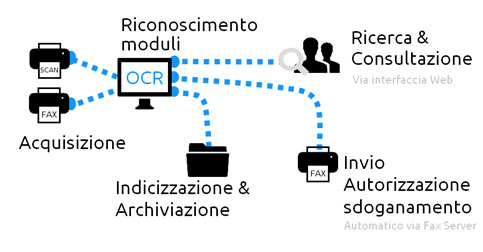Thanks to our countless years of experience in the public sector, we offer tailored solutions to help our customers optimize their document management needs.
The available configurations of an Enterprise Content Management system in the public administration field, both central and local, are varied and focused on rationalizing processes.
We also perform scanning and extraction services of forms and questionnaires with advanced Data Capture technologies (OCR/ICR/OMR/FFP).
Our solutions are always available both on premise and in the Cloud at our Data Center.
In the Public Administration sector, we have developed numerous applications including bill of lading management with the objective of verifying all goods entering a state. In this specific application, all companies must fax a copy of the bills with the appropriate title page to the Police Department.
The bills are extracted from the FAX Server and transmitted to the OCR software for recognition of the title page. The bills are then filed on IBM’s platform and made available to the police headquarters for verification.
The police HQ returns the first page of the bills to the companies, along with a discharge authorization.
Our Invoice Management platform was developed to comply with the obligation for Italian companies to send their invoices to the Income Revenue Authority on a scheduled frequency.
The invoices are acquired locally and archived on an IBM platform.
The basic functions of this type of project can be outlined with the following diagram:

This solution was designed to automatically manage the correction of admissions tests for academic degrees at a national level.
For each candidate it was required to analyze:
The two forms were linked together only by a barcode so as not to disclose, during the correction phase, which candidate the results corresponded to.
The application first analyzed all the answer forms by scanning and indexing them through OCR/ICR software, then proceeded to correct the answers with the assignment of a relative score, and lastly exported the data to a database.
Subsequently, the software analyzed the personal data forms by scanning, recognizing the data entered, and associating the personal data with the results through the assignment of a bar code.
The two actions took place in different intervals and completely automatic. In the case of difficulty in recognizing certain fields, the software notified an operator for manual verification.
In the Public Administration sector, we have developed numerous applications including bill of lading management with the objective of verifying all goods entering a state. In this specific application, all companies must fax a copy of the bills with the appropriate title page to the Police Department.
The bills are extracted from the FAX Server and transmitted to the OCR software for recognition of the title page. The bills are then filed on IBM’s platform and made available to the police headquarters for verification.
The police HQ returns the first page of the bills to the companies, along with a discharge authorization.
Our Invoice Management platform was developed to comply with the obligation for Italian companies to send their invoices to the Income Revenue Authority on a scheduled frequency.
The invoices are acquired locally and archived on an IBM platform.
The basic functions of this type of project can be outlined with the following diagram:

This solution was designed to automatically manage the correction of admissions tests for academic degrees at a national level.
For each candidate it was required to analyze:
The two forms were linked together only by a barcode so as not to disclose, during the correction phase, which candidate the results corresponded to.
The application first analyzed all the answer forms by scanning and indexing them through OCR/ICR software, then proceeded to correct the answers with the assignment of a relative score, and lastly exported the data to a database.
Subsequently, the software analyzed the personal data forms by scanning, recognizing the data entered, and associating the personal data with the results through the assignment of a bar code.
The two actions took place in different intervals and completely automatic. In the case of difficulty in recognizing certain fields, the software notified an operator for manual verification.